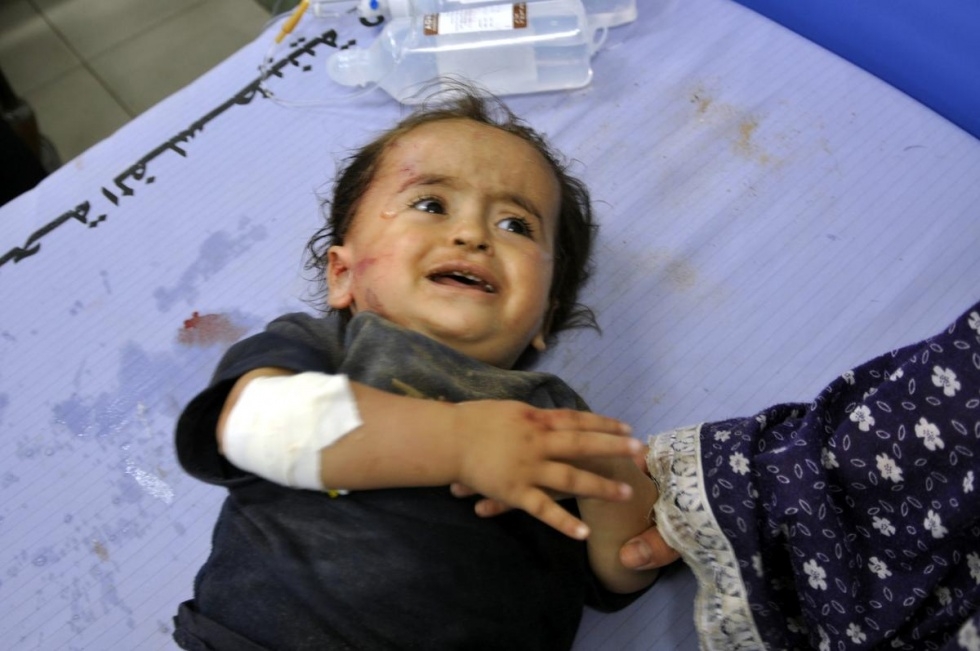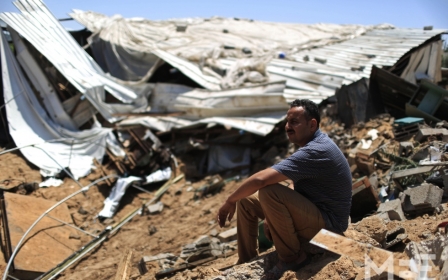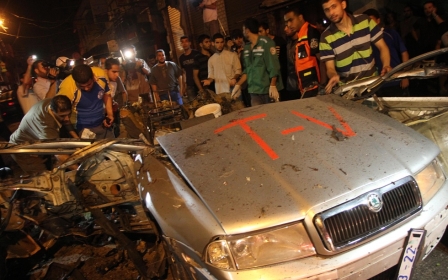A day under drones in Gaza

It was a busy day for Palestinian photojournalist Mohammed Asad following Israel's military offensive, dubbed by Tel Aviv Operation Protective Edge, against the besieged Gaza Strip.
After covering stories of the deceased at a funeral and of the dying at al-Shifa hospital, he was just meters away from meeting the Grim Reaper personally as he was heading back home after finishing his day's work.
"I'm in a state of shock now, please let's talk later," he told Middle East Eye over the phone during the first call made to him on Wednesday.
"I was walking with my colleague, and we were carrying our cameras, which have large lenses that should be visible. But despite that Israeli drones fired a rocket 20 meters away from us," he later explained during a second call.
He could hear the missile as it got nearer, but ultimately it missed him. Not everyone on the street was as fortunate.
"It hit the entrance of a taxi station, killing one child and injuring two people," he said, shaken by two factors, having witnessed the death of a child and feeling that he too was not far from meeting a similar fate.
Asad insisted that there were no apparent targets that warranted an Israeli attack on that street.
"If indeed there was a target, although it seems there wasn't, [the Israelis] could have waited for people to pass before firing," he said.
He described the mood in Gaza to be of devastation coupled with defiance.
"People who have lost their loved ones are in a terrible state, but in general those who have not been affected, whose houses are still up, have high morale, and they strongly support the resistance," he noted.
Asad explained that there had been a general pattern to the Israeli raids, but added that there were frequent exceptions to that pattern, which lead to high civilian casualties.
"The norm for the Israeli military is that first they hit a house with a small rocket from a drone, whereby the people would rush out before a second strike hits the house, but this time from an F16, which demolishes the house," said Asad.
"However, there are many times when the Israelis fire from an F16 without a prior warning, which results in the death of those who are inside," he added.
Earlier on in the day, Asad was at the main hospital in Gaza City, al-Shifa hospital.
"People are devastated there, bodies of children, of a pregnant woman," he said, before sending MEE pictures that were too gruesome for publishing.
Asad also noted the frequent Israeli raids on farms in Gaza.
"There is a lot of Israeli targeting of farm land. They claim that they are searching for the resistance, but they hit everywhere – burning even the soil, like they want to teach us a lesson," he said.
His testimony on the targeting of farm land was echoed by Wafaa Abu Rahma, a Palestinian translator from the Nusayrat district of Gaza.
"They were shelling empty areas and farms, [the Israelis] fear that there are fighters or rocket launchers there. It seems that all of the nearby farming areas are targeted. Many trees have been destroyed," she said.
Abu Rahma noted that it is relatively calm in the Nusayrat district.
"Sometimes shrapnel would fall on the nearby houses, breaking the glass. In our case, the house was shaken but we suffered no material losses," she said.
But like many in the bombarded Strip, she stayed at home for most of the day.
"I work in Gaza City but today I could not go, there is no public transport. It's hot and people are fasting, but if they need to go somewhere they have to walk," she said.
"The UNRWA clinic is shut but some pharmacies have opened. Most shops are shut, but some bakeries and food stores are open," she added.
"All banks are shut. Western Union branches are open but they are only available in Gaza City," she noted, adding that "everyone is having cash problems and people are having difficulties getting the things they need."
Her testimony was shared by Hani Abushiba, a freelance journalist from Shujaiyya district.
"There is little movement in the streets; people only go out for necessity. Gaza has been transformed into a city of ghosts. Anything that moves is at risk of being targeted, motorbikes or bikes," he said, adding that "two brothers who were shopping were killed by Israeli strikes."
With no access to the internet and having power outages that last, on average, 16 hours a day, "my mobile [phone] is the only connection to the outside world until the battery charge dies," he said.
Abushiba said that "prices have not gone up yet but the shops are open for less hours [than usual]."
He also noted that Israeli drones have become a common sight in Gaza.
"I see 10 - 15 drones around a small area. The drones pass by every 5 – 7 minutes," he said
As he was on the phone with MEE, the sound of what he said was a passing missile could be heard.
"Did you hear it? That was the sound of a missile passing just now!"
Middle East Eye propose une couverture et une analyse indépendantes et incomparables du Moyen-Orient, de l’Afrique du Nord et d’autres régions du monde. Pour en savoir plus sur la reprise de ce contenu et les frais qui s’appliquent, veuillez remplir ce formulaire [en anglais]. Pour en savoir plus sur MEE, cliquez ici [en anglais].



